A Combination of Enhanced Mechanical and Electromagnetic Shielding Properties of Carbon Nanotubes Reinforced Cu-Ni Composite Foams
Abstract
:1. Introduction
2. Experimental Section
2.1. Preparation of Composite Foams
2.2. Characterization
3. Results and Discussion
3.1. Morphology and Composition of the Composite
3.2. Compressive Property
3.3. Electromagnetic Shielding Performance
4. Conclusions
Author Contributions
Funding
Institutional Review Board Statement
Informed Consent Statement
Data Availability Statement
Conflicts of Interest
References
- Liu, P. Mechanical relations for porous metal foams under several typical loads of shearing, torsion and bending. Mater. Sci. Eng. A 2010, 527, 7961–7966. [Google Scholar] [CrossRef]
- Banhart, J. Manufacture, characterisation and application of cellular metals and metal foams. Prog. Mater. Sci. 2001, 46, 559–632. [Google Scholar] [CrossRef]
- Qin, J.; Chen, Q.; Yang, C.; Huang, Y. Research process on property and application of metal porous materials. J. Alloys Compd. 2016, 654, 39–44. [Google Scholar] [CrossRef]
- Duarte, I.; Ferreira, J.M.F. Composite and Nanocomposite Metal Foams. Materials 2016, 9, 79. [Google Scholar] [CrossRef] [Green Version]
- Liu, Q.; He, X.; Yi, C.; Sun, D.; Chen, J.; Wang, D.; Liu, K.; Li, M. Fabrication of ultra-light nickel/graphene composite foam with 3D interpenetrating network for high-performance electromagnetic interference shielding. Compos. Part B Eng. 2020, 182, 107614. [Google Scholar] [CrossRef]
- Kim, S.; Lee, C.-W. A Review on Manufacturing and Application of Open-cell Metal Foam. Procedia Mater. Sci. 2014, 4, 305–309. [Google Scholar] [CrossRef]
- Nakajima, H. Fabrication, properties and application of porous metals with directional pores. Prog. Mater. Sci. 2007, 52, 1091–1173. [Google Scholar] [CrossRef]
- Du, H.; Song, G.; Nakajima, H.; Zhao, Y.; Xiao, J.; Xiong, T. Study on lotus-type porous copper electroplated with a Ni coating on inner surface of pores. Appl. Surf. Sci. 2013, 264, 772–778. [Google Scholar] [CrossRef]
- Du, H.; Cui, C.; Liu, H.; Song, G.; Xiong, T. Improvement on compressive properties of lotus-type porous copper by a nickel coating on pore walls. J. Mater. Sci. Technol. 2020, 37, 114–122. [Google Scholar] [CrossRef]
- Fugetsu, B.; Sano, E.; Sunada, M.; Sambongi, Y.; Shibuya, T.; Wang, X.; Hiraki, T. Electrical conductivity and electromagnetic interference shielding efficiency of carbon nanotube/cellulose composite paper. Carbon 2008, 46, 1256–1258. [Google Scholar] [CrossRef]
- Wan, T.; Liu, Y.; Zhou, C.; Chen, X.; Li, Y. Fabrication, properties, and applications of open-cell aluminum foams: A review. J. Mater. Sci. Technol. 2021, 62, 11–24. [Google Scholar] [CrossRef]
- Duarte, I.; Ventura, E.; Olhero, S.; Ferreira, J.M. A novel approach to prepare aluminium-alloy foams reinforced by carbon-nanotubes. Mater. Lett. 2015, 160, 162–166. [Google Scholar] [CrossRef]
- Ma, Y.; Yang, X.; He, C.; Yang, K.; Xu, J.; Sha, J.; Shi, C.; Li, J.; Zhao, N. Fabrication of in-situ grown carbon nanotubes reinforced aluminum alloy matrix composite foams based on powder metallurgy method. Mater. Lett. 2018, 233, 351–354. [Google Scholar] [CrossRef]
- Duarte, I.; Ventura, E.; Olhero, S.; Ferreira, J.M. An effective approach to reinforced closed-cell Al-alloy foams with multiwalled carbon nanotubes. Carbon 2015, 95, 589–600. [Google Scholar] [CrossRef]
- Ji, K.; Zhao, H.; Zhang, J.; Chen, J.; Dai, Z. Fabrication and electromagnetic interference shielding performance of open-cell foam of a Cu–Ni alloy integrated with CNTs. Appl. Surf. Sci. 2014, 311, 351–356. [Google Scholar] [CrossRef]
- Congzhen, W.; Xueping, G.; Jingmei, T.; Ming, X.; Jianhong, Y.; Yichun, L. Compression and electromagnetic shielding properties of CNTs reinforced copper foams prepared through electrodeposition. Vacuum 2019, 167, 159–162. [Google Scholar]
- Ma, R.; Li, W.; Huang, M.; Feng, M.; Liu, X. The reinforcing effects of dendritic short carbon fibers for rigid polyurethane composites. Compos. Sci. Technol. 2019, 170, 128–134. [Google Scholar] [CrossRef]
- An investigation of grain boundary dif-fusion and segregation of Ni in Cu in an electrodeposited Cu/Ni micro-multilayer system. Mater. Lett. 2021, 89, 223–225.
- Kunimine, T.; Watanabe, M. A Comparative Study of Hardness in Nanostructured Cu–Zn, Cu–Si and Cu–Ni Solid-Solution Alloys Processed by Severe Plastic Deformation. Mater. Trans. 2019, 60, 1484–1488. [Google Scholar] [CrossRef] [Green Version]
- Eugénio, S.; Silva, T.M.; Carmezim, M.J.; Duarte, R.G.; Montemor, M.F. Electrodeposition and characterization of nickel–copper metallic foams for application as electrodes for supercapacitors. J. Appl. Electrochem. 2013, 44, 455–465. [Google Scholar] [CrossRef]
- Wang, C.; Gan, X.; Tao, J.; Xie, M.; Yi, J.; Liu, Y. Simultaneous achievement of high strength and high ductility in copper matrix composites with carbon nanotubes/Cu composite foams as reinforcing skeletons. Nanotechnology 2019, 31, 045701. [Google Scholar] [CrossRef]
- Chen, X.; Tao, J.; Yi, J.; Liu, Y.; Bao, R.; Li, C.; Tan, S.; You, X. Enhancing the strength of carbon nanotubes reinforced copper matrix composites by optimizing the interface structure and dispersion uniformity. Diam. Relat. Mater. 2018, 88, 74–84. [Google Scholar] [CrossRef]
- Gubicza, J.; Jenei, P.; Nam, K.; Kádár, C.; Jo, H.; Choe, H. Compressive behavior of Cu-Ni alloy foams: Effects of grain size, porosity, pore directionality, and chemical composition. Mater. Sci. Eng. A 2018, 725, 160–170. [Google Scholar] [CrossRef]
- Lu, X.; Zhang, Z.; Du, H.; Luo, H.; Mu, Y.; Xu, J. Compressive behavior of Mg alloy foams at elevated temperature. J. Alloy. Compd. 2019, 797, 727–734. [Google Scholar] [CrossRef]
- Suárez, S.; Soldera, F.; Oliver, C.G.; Acevedo, D.; Mücklich, F. Thermomechanical Behavior of Bulk Ni/MWNT Composites Produced via Powder Metallurgy. Adv. Eng. Mater. 2012, 14, 499–502. [Google Scholar] [CrossRef]
- Scharf, T.W.; Neira, A.; Hwang, J.Y.; Tiley, J.; Banerjee, R. Self-lubricating carbon nanotube reinforced nickel matrix composites. J. Appl. Phys. 2009, 106, 013508. [Google Scholar] [CrossRef]
- Huihui, Z. Research on the Preparation and Properties of Electromagnetic Shielding Materials with Foam Structure. Master’s Thesis, Nanjing University of Aeronautics and Astronautics, Nanjing, China, 2014. [Google Scholar]
- Yang, X.-D.; Cheng, Y.; He, X.-L.; Yang, K.-M.; Zong, R.-R. Effect of Heat Treatment on the Microstructure, Compressive Property, and Energy Absorption Response of the Al–Mg–Si Alloy Foams. Adv. Eng. Mater. 2021, 23. [Google Scholar] [CrossRef]
- Alia, R.; Cantwell, W.; Langdon, G.; Yuen, S.; Nurick, G. The energy-absorbing characteristics of composite tube-reinforced foam structures. Compos. Part B Eng. 2014, 61, 127–135. [Google Scholar] [CrossRef]
- Chen, B.; Shen, J.; Ye, X.; Imai, H.; Umeda, J.; Takahashi, M.; Kondoh, K. Solid-state interfacial reaction and load transfer efficiency in carbon nanotubes (CNTs)-reinforced aluminum matrix composites. Carbon 2017, 114, 198–208. [Google Scholar] [CrossRef]
- Schelkunoff, S.A. Electromagnetic Waves; David Van Nostrand: New York, NY, USA, 1943; 530p. [Google Scholar]
- Schelkunoff, S.A. The Electromagnetic Theory of Coaxial Transmission Lines and Cylindrical Shields. Bell Syst. Tech. J. 1934, 13, 532–579. [Google Scholar] [CrossRef]
- Liu, C.; Wang, X.; Huang, X.; Liao, X.-P.; Shi, B. Absorption and Reflection Contributions to the High Performance of Electromagnetic Waves Shielding Materials Fabricated by Compositing Leather Matrix with Metal Nanoparticles. ACS Appl. Mater. Interfaces 2018, 10, 14036–14044. [Google Scholar] [CrossRef]
- Ji, K.; Zhao, H.; Huang, Z.; Dai, Z. Performance of open-cell foam of Cu–Ni alloy integrated with graphene as a shield against electromagnetic interference. Mater. Lett. 2014, 122, 244–247. [Google Scholar] [CrossRef]
- Chen, Z.; Xu, C.; Ma, C.; Ren, W.; Cheng, H.-M. Lightweight and Flexible Graphene Foam Composites for High-Performance Electromagnetic Interference Shielding. Adv. Mater. 2013, 25, 1296–1300. [Google Scholar] [CrossRef]
- Chen, X.H.; Lu, L.; Lu, K. Electrical resistivity of ultrafine-grained copper with nanoscale growth twins. J. Appl. Phys. 2007, 102, 083708. [Google Scholar] [CrossRef] [Green Version]
- Kumar, R.; Jain, H.; Sriram, S.; Chaudhary, A.; Khare, A.; Chilla, V.; Mondal, D. Lightweight open cell aluminum foam for superior mechanical and electromagnetic interference shielding properties. Mater. Chem. Phys. 2019, 240, 122274. [Google Scholar] [CrossRef]
- Ma, Z.; Li, J.; Zhang, J.; He, A.; Dong, Y.; Tan, G.; Ning, M.; Man, Q.; Liu, X. Ultrathin, flexible, and high-strength Ni/Cu/metallic glass/Cu/Ni composite with alternate magneto-electric structures for electromagnetic shielding. J. Mater. Sci. Technol. 2021, 81, 43–50. [Google Scholar] [CrossRef]
- Zhang, H.; Zhang, G.; Gao, Q.; Tang, M.; Ma, Z.; Qin, J.; Wang, M.; Kim, J.-K. Multifunctional microcellular PVDF/Ni-chains composite foams with enhanced electromagnetic interference shielding and superior thermal insulation performance. Chem. Eng. J. 2020, 81, 43–50. [Google Scholar] [CrossRef]
- Yu, W.-C.; Zhang, G.-Q.; Liu, Y.-H.; Xu, L.; Yan, D.-X.; Huang, H.-D.; Tang, J.-H.; Xu, J.-Z.; Li, Z.-M. Selective electromagnetic interference shielding performance and superior mechanical strength of conductive polymer composites with oriented segregated conductive networks. Chem. Eng. J. 2019, 373, 556–564. [Google Scholar] [CrossRef]

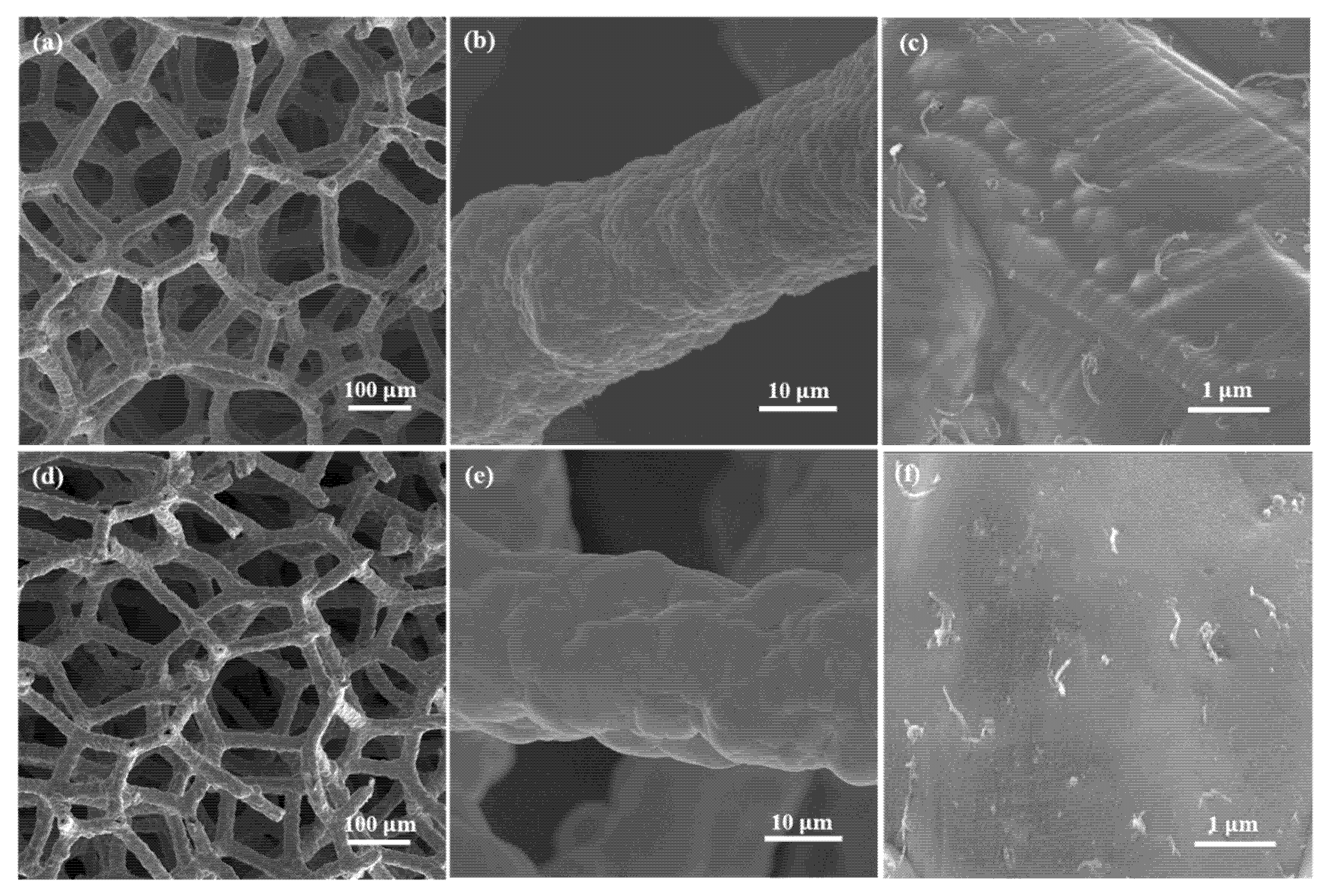
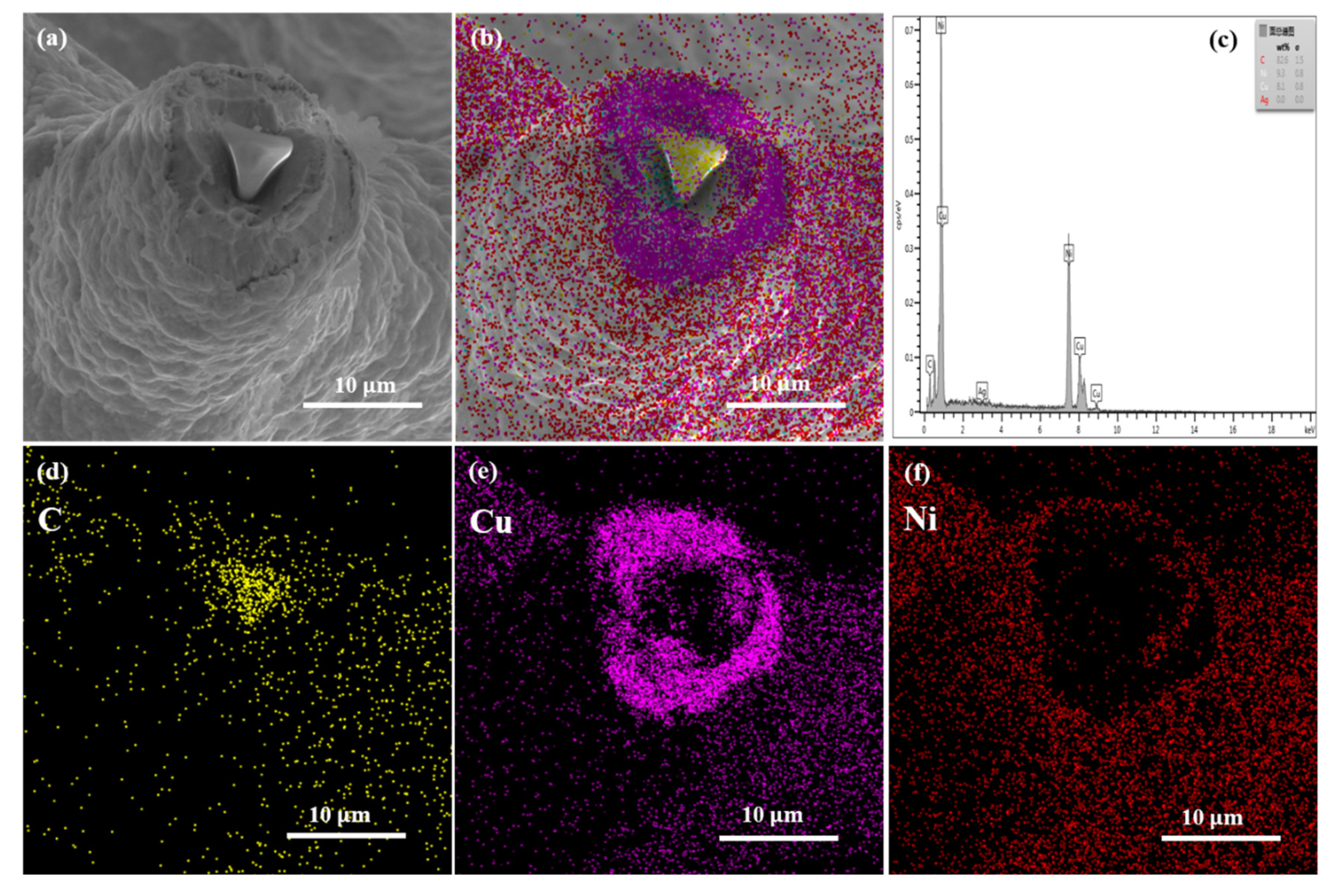
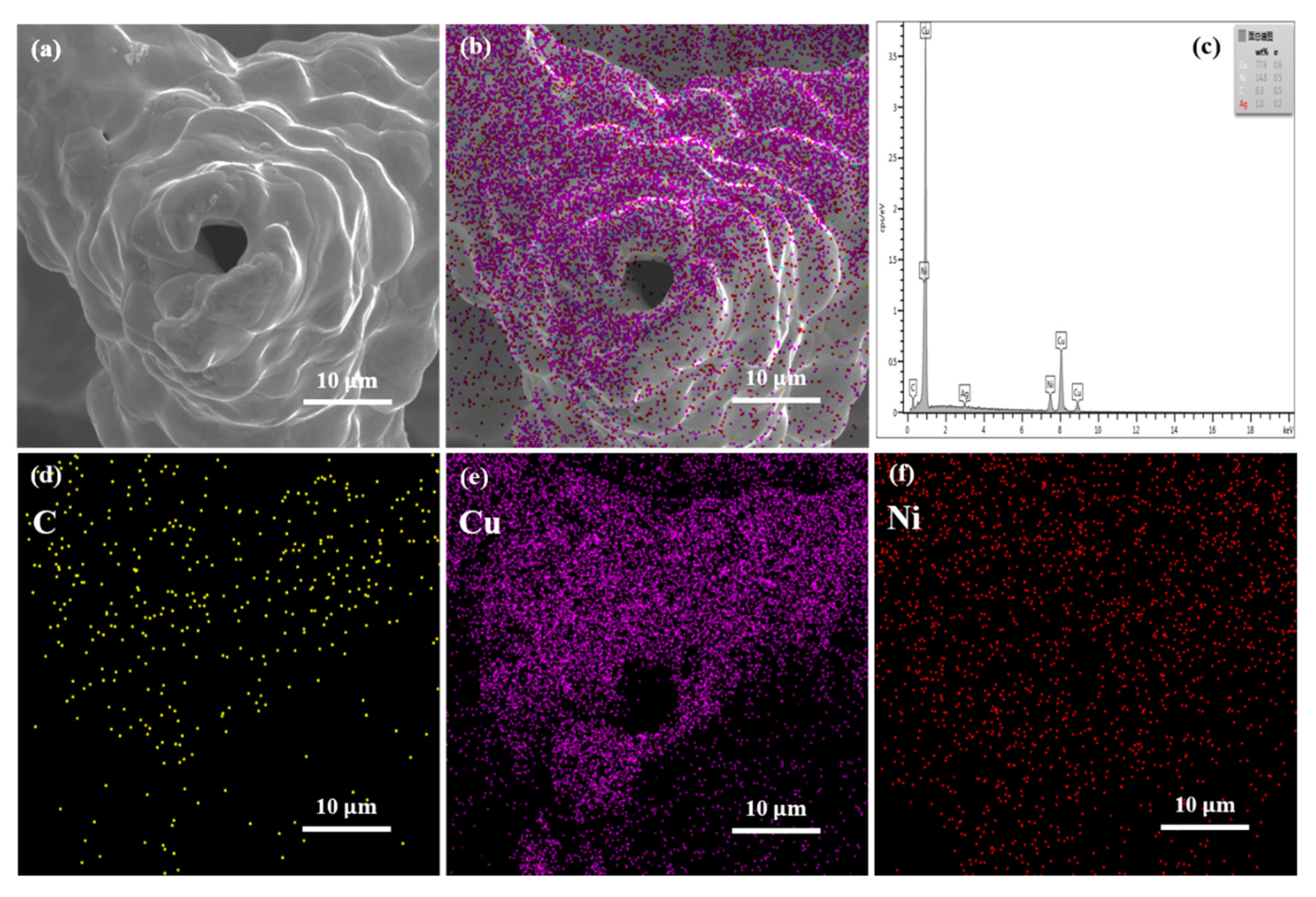
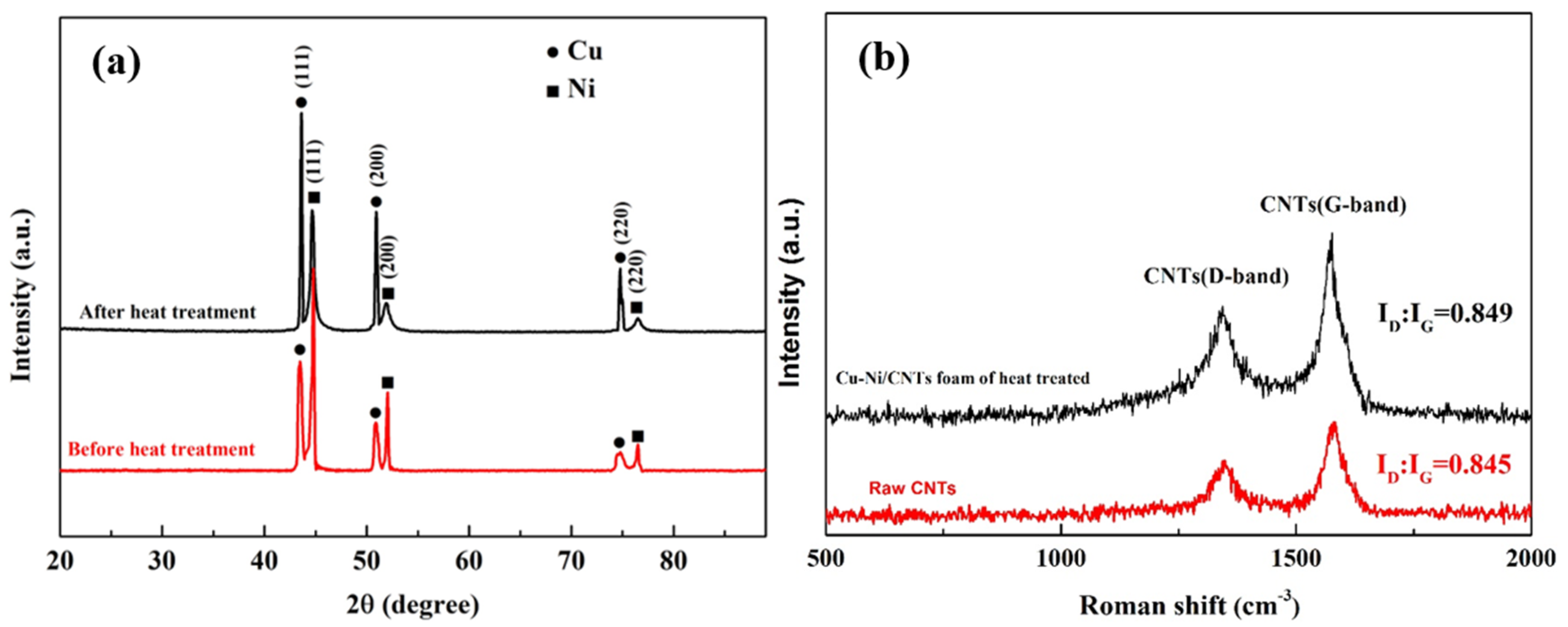


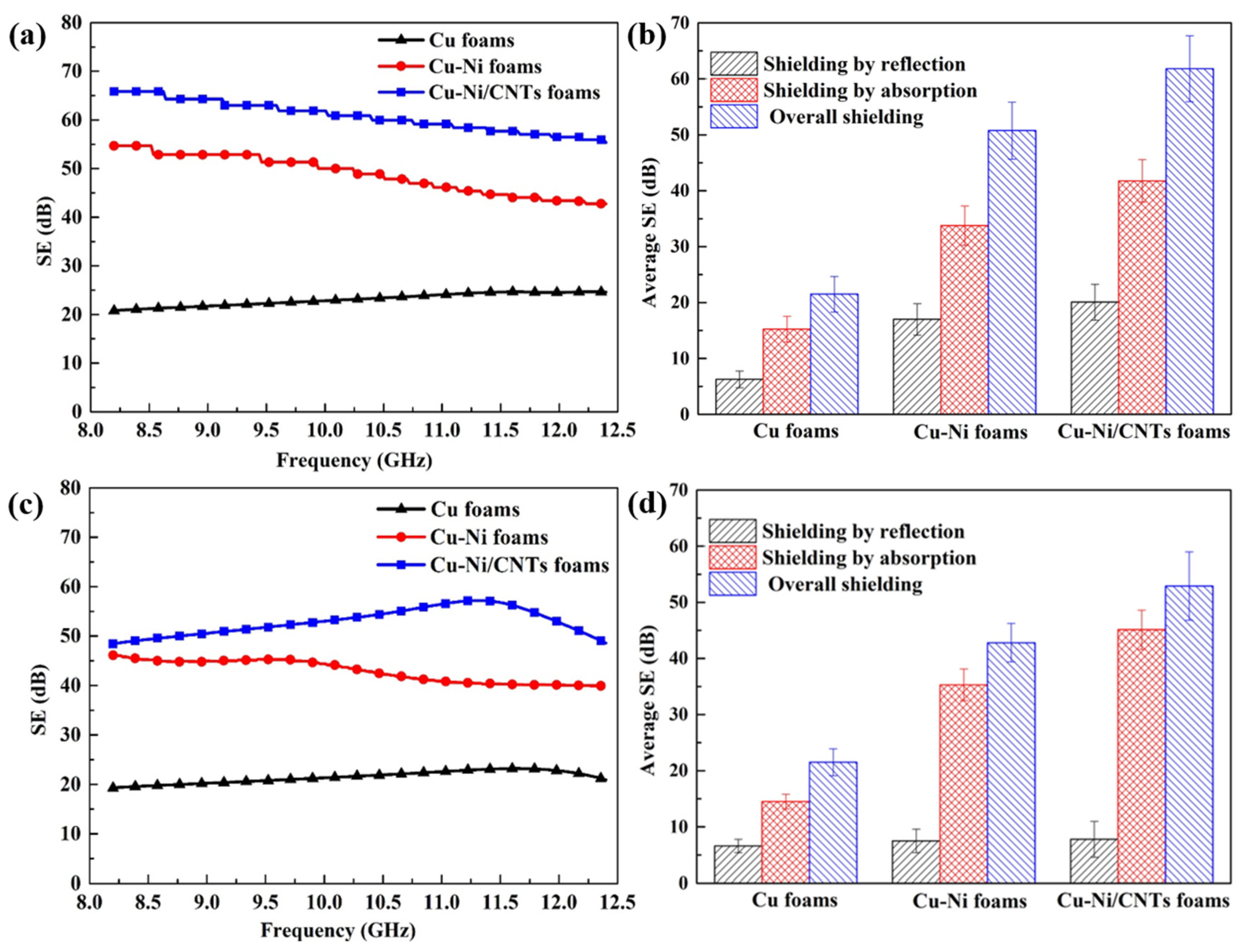
| Sample | Density (g cm−3) | Porosity (%) |
|---|---|---|
| Cu foams | 0.98 | 89.0 |
| Cu-Ni foams | 1.13 | 87.3 |
| Cu-Ni/CNTs foams | 1.14 | 87.1 |
| Materials | Method | Frequency (GHz) | SE(dB) | Ref. |
|---|---|---|---|---|
| Cu-Ni/CNTs foam (before heat treatment) | electrodeposition | 8.2–12.4 | 61.8 | This work |
| Cu-Ni/CNTs foam (after heat treatment) | electrodeposition | 8.2–12.4 | 52.9 | This work |
| Cu-Ni-CNTs foam | electroless plating and electrophoretic deposition | 8.2–12.4 | 47.5 | [15] |
| CNTs/Cu foam | electrodeposition | 8.2–12.4 | 33.6 | [16] |
| open cell Al-foam | replica impregnation method | 8.2–12.4 | 44.6 | [37] |
| Ni/Cu/metallic glass/Cu/Ni composite | electroless plating | 8–12 | 35 | [38] |
| PVDF/Ni-chains composite foam | compression molding | 8.2–12.4 | 26.8 | [39] |
| CNT/TPU | microwave selective sintering | 8–18 | 34 | [40] |
Publisher’s Note: MDPI stays neutral with regard to jurisdictional claims in published maps and institutional affiliations. |
© 2021 by the authors. Licensee MDPI, Basel, Switzerland. This article is an open access article distributed under the terms and conditions of the Creative Commons Attribution (CC BY) license (https://creativecommons.org/licenses/by/4.0/).
Share and Cite
Wang, D.; Wu, Z.; Li, F.; Gan, X.; Tao, J.; Yi, J.; Liu, Y. A Combination of Enhanced Mechanical and Electromagnetic Shielding Properties of Carbon Nanotubes Reinforced Cu-Ni Composite Foams. Nanomaterials 2021, 11, 1772. https://doi.org/10.3390/nano11071772
Wang D, Wu Z, Li F, Gan X, Tao J, Yi J, Liu Y. A Combination of Enhanced Mechanical and Electromagnetic Shielding Properties of Carbon Nanotubes Reinforced Cu-Ni Composite Foams. Nanomaterials. 2021; 11(7):1772. https://doi.org/10.3390/nano11071772
Chicago/Turabian StyleWang, Dan, Zhong Wu, Fengxian Li, Xueping Gan, Jingmei Tao, Jianhong Yi, and Yichun Liu. 2021. "A Combination of Enhanced Mechanical and Electromagnetic Shielding Properties of Carbon Nanotubes Reinforced Cu-Ni Composite Foams" Nanomaterials 11, no. 7: 1772. https://doi.org/10.3390/nano11071772
APA StyleWang, D., Wu, Z., Li, F., Gan, X., Tao, J., Yi, J., & Liu, Y. (2021). A Combination of Enhanced Mechanical and Electromagnetic Shielding Properties of Carbon Nanotubes Reinforced Cu-Ni Composite Foams. Nanomaterials, 11(7), 1772. https://doi.org/10.3390/nano11071772





